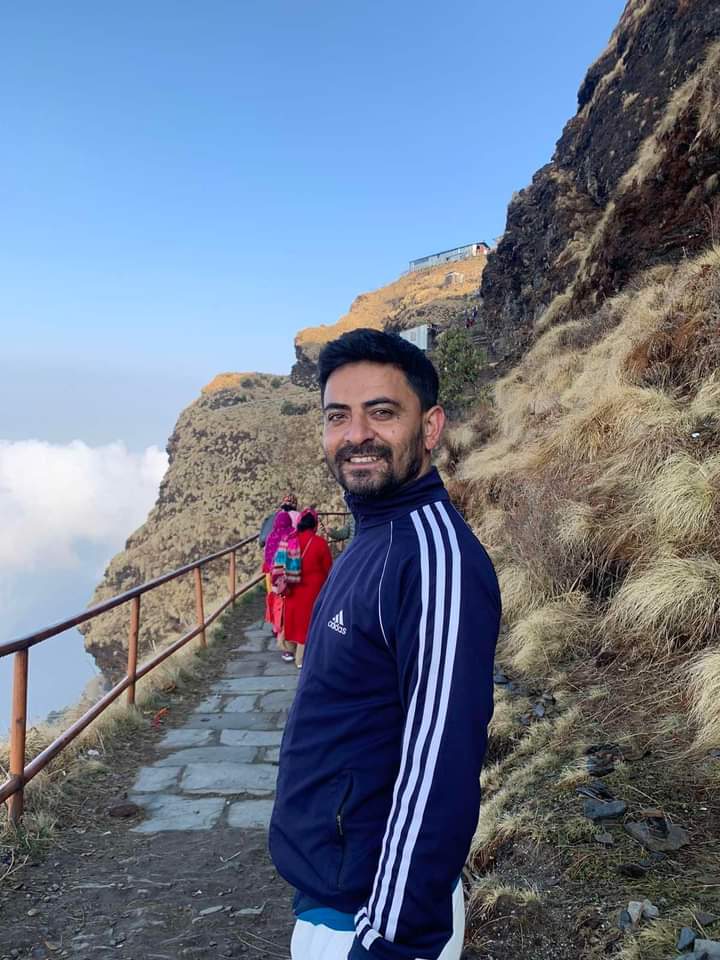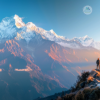We are always available for your help
Trip Fact
These are some important facts about Ghorepani Poon Hill trek.
-
Max Altitude 3210m /10532.01 .ft
-
Difficulty Easy
-
Duration 9 Days
-
Trip Profile Ghorepani Poon Hill Trek, Annapurna Region
-
Type Trekking
-
Accommodation 3 star hotel in Kathmandu, Pokhara and tea house during the trek
-
Meal Plan Breakfast in Kathmandu & Pokhara. Full board meals during trek.
Overview
The Poonhill trek is one of the short, light and comfortable treks in the Annapurna region. The trek offers us the chance to have up close views of mountainous and hilly vistas along the way. We will mostly be doing uphill climbing until reaching Poonhill. The trail takes us through hills, fields, valleys and Magar and Gurung villages. The beauty of streams, rivers and waterfalls along the way help to give cool and soothing sensation during the arduous walk. The colourful rhododendron forests and green fields add beauty to the trek.
During the trek, we will stop by at restaurants along the way where they serve traditional Nepali food- Daal, Bhat, curry and Achar. You will have a chance to taste the traditional and authentic Nepali cuisine. The warm hospitality you receive at the hotels is really appreciative. We will be spending our nights in the hotels at our stopping places.
The major highlight of the trek is morning sunrise view from the Poohill that gives a majestic view of a mountain range when the sun shines upon the peaks. The mountain peaks like Annapurna I( a tenth highest mountain in the world), Annapurna south, Himchuli, Mt Fishtail(Machhapuchre), Nilgiri south, Tukuche peak, Mt Dhaulagiri I ( a seventh highest mountain in the world)and others can be viewed close from there. We will also be stopping and taking rest at different places during the trek to enjoy and admire the natural beauty. Sometimes the trail can be slippery during the rainfall and snowfall and we have to be extra careful during that time. The trails are mostly stone stepped and some are also in the rocky areas. Throughout the trek, the breathtaking view of snowy peaks contrasted with the green landscapes will keep you rejuvenated and make you feel exhilarated. Once you try out this trek we are sure you would want to tread this trail many times in the future as well.
9 Day(s) Detailed Itinerary
Arrival on:Kathmandu, Nepal
Departure from: Kathmandu, Nepal
Arrival In Kathmandu
Kathmandu Sightseeing
Drive to Pokhara
Ulleri to Ghorepani
Ghorepani to Tadapani trek
Ghorepani to Tadapani
Tadapani to Ghandruk
Ghandruk to Pokhara
Pokhara To Kathmandu
Final Departure
What's included ?
- A porter and his entire expenses.
- Airport pickup and drop facility.
- Breakfast,Lunch and dinner during the trek.
- Down jackets and sleeping bags (provided upon request).
- First aid medical kit
- Fresh seasonal fruits after the dinner (while on the trek).
- Full day guided city tour in Kathmandu (Day 2) by a private vehicle.
- Insurance of guide and porter.
- Kathmandu-Pokhara-Kathmandu travel in a deluxe bus.
- Licensed, experienced and English speaking trekking guide.
- Lodge expenses during the trek.
- One porter for two people.
- Stay in the city at finest hotel (3 nights twin sharing room at Kathmandu and 2 nights at Pokhara).
- Trekking permits/TIMS.
- Upscale Adventures duffel bag, t-shirt, and trekking map.
- Welcome and farewell dinner at one of the finest Nepalese Restaurant with traditional ethnic music and dance.
What's not included ?
- Additional meals and drinks
- Cost for additional trips.
- International airfare to and from Kathmandu
- Meals in the city except for breakfast and other mentioned special dinner.
- Nepal arrival visa.
- Personal expenses (phone calls, laundry, bar bills, battery recharge, extra porters, bottle or boiled water, shower, etc.)
- Tipping to staffs (as an appreciation).
- Travel insurance which covers emergency rescue and evacuation
Departures
The given cost are per person and exclude international flights. Given below are the departure dates available for online booking. If the given date is not favorable then please write us and we will happily customize your trip on dates more appropriate for you.
Please Check Available Dates for The Year of:
What is the Ghorepani Poonhill Trek and how long does it typically take?
The Ghorepani Poon Hill Trek is a renowned short trek located in the heart of Nepal’s Annapurna region, primarily famous for its iconic panoramic sunrise views from Poon Hill. It has earned the affectionate moniker, the “Annapurna Sunrise Trek,” due to the truly spectacular vistas it offers of the towering Annapurna and Dhaulagiri mountain ranges. This trek is a perfect blend of natural beauty and cultural immersion, making it a highly sought-after experience for travelers.
Regarding its duration, the standard Ghorepani Poon Hill Trek typically spans 4 days of walking. This timeframe allows for a comfortable pace, offering ample opportunity to soak in the scenery and cultural experiences. For travelers with tighter schedules or those looking for a quicker mountain escape, a shorter
3-day version is also possible, particularly when starting from Pokhara, thanks to improved road access to the trailhead. This flexibility in duration is a significant advantage, as it makes the trek incredibly time-efficient compared to other popular expeditions like the Annapurna Base Camp Trek (8-10 days) or the extensive Annapurna Circuit (18 days). This shorter commitment broadens its appeal not only to first-time trekkers but also to individuals with limited vacation time, those combining trekking with other activities in Nepal, or even families seeking a manageable yet rewarding adventure.
How challenging is the Ghorepani Poonhill Trek, and is it suitable for all ages?
The Ghorepani Poonhill Trek is widely regarded as an easy to moderate trekking trail. Its accessibility makes it a highly recommended choice for travelers of various age groups and fitness levels, and it is often celebrated as a
family trekking route. This classification places it among the “Easier Treks” within Nepal’s diverse trekking spectrum, indicating that it does not demand the same strenuous physical conditioning as more challenging high-altitude expeditions.
While the overall difficulty is lower compared to high-altitude expeditions, trekkers should be prepared for numerous uphill and downhill sections, particularly continuous walking on staircase trails. These specific segments can be quite demanding on the knees and leg muscles and may lead to muscle strain or knee lock if trekkers are not adequately prepared. Therefore, while extensive prior trekking experience is not strictly required, a reasonable level of general fitness and stamina is highly beneficial. Incorporating exercises that build leg strength and endurance, especially focusing on stair climbing or similar activities, into one’s routine prior to the trek can significantly enhance comfort and help prevent discomfort or injury during these specific trail sections. This preparation ensures a more enjoyable and injury-free experience, allowing trekkers to fully appreciate the journey.
When is the best time to embark on the Ghorepani Poonhill Trek for optimal views?
While the Ghorepani Poonhill Trek is technically possible throughout the year, the ideal times to visit for the best experience and consistently clear skies are during the Spring and Autumn seasons. These periods offer the most favorable weather conditions and unparalleled mountain visibility, ensuring a truly spectacular trekking experience.
Spring (March, April, and May): This season brings mild temperatures and is particularly renowned for the vibrant bloom of rhododendron forests that carpet the hillsides, creating a stunning, colorful landscape. Trekking amidst these natural floral displays adds an extraordinary dimension to the scenic beauty, transforming the journey into a visually immersive experience. This unique seasonal feature can be a powerful draw for nature lovers and photographers seeking a distinct and memorable adventure.
Autumn (September, October, and November): Often considered the peak trekking season, Autumn is characterized by stable, clear weather, offering excellent visibility and spectacular, crisp mountain views. Days are typically warm and sunny, while nights are cool, providing perfect trekking conditions.
Other seasons offer different experiences. Winter (December to February), while colder, provides vivid colors, a chance of snowfall, and fewer crowds. However, the
Monsoon Season (June to August) is generally less recommended due to daily heavy rainfall, wet and muddy trails, and views often obscured by clouds. Landslides can also be a concern during this time. Nevertheless, it is still possible for adventurous trekkers to complete the trek in monsoon with appropriate waterproof gear.
What permits are necessary for the Ghorepani Poonhill Trek?
Yes, permits are absolutely mandatory for the Ghorepani Poonhill Trek, as the entire route falls within the protected and ecologically significant Annapurna Conservation Area. To legally undertake this trek, trekkers will need two main permits:
ACAP (Annapurna Conservation Area Permit): This permit is required for entry into and trekking within the Annapurna Conservation Area Project. The fees collected from these permits contribute directly to the conservation efforts and sustainable development of the region, helping to preserve its natural beauty and unique ecosystems.
TIMS (Trekkers Information Management System) Card: This card is essential for tracking trekkers’ movements, ensuring their safety, and assisting in emergency situations. It helps authorities monitor trekking activities and respond effectively if needed, providing an added layer of security for all trekkers.
Your chosen trekking agency will typically assist with the entire process of obtaining these permits, and the cost is often included as part of your trek package, simplifying the logistical aspects for trekkers. Trekkers will generally be required to provide scanned copies of their passport details and a passport-sized photograph to their agency for this purpose.
What type of accommodation and dining can I expect during the Ghorepani Poonhill Trek?
Your trekking experience combines comfortable city stays with authentic teahouse lodging along the trail, offering a genuine taste of local life and culture.
Accommodation: In cities like Kathmandu and Pokhara (if the itinerary includes overnight stays), trekkers can expect comfortable and clean 3-star hotels equipped with en-suite bathrooms, hot showers, and flushing toilets. During the trek itself, accommodation is primarily in charming
teahouses or lodges. These typically offer solid beds with foam mattresses in shared rooms, often on a twin-sharing basis. While some teahouses at lower elevations may offer attached bathrooms, shared toilet facilities are common and can be quite basic, especially as trekkers ascend to higher points like Tadapani. It is important to note that amenities such as Wi-Fi access, battery charging, and hot showers at teahouses often incur small additional charges, which are typically not included in the base package price. Being aware of these common “optional extras” helps manage expectations and prevent budget surprises during the trek.
Dining: All three meals—breakfast, lunch, and dinner—are typically included throughout the trekking days. Teahouses provide a diverse menu featuring a variety of options, including delicious local Nepalese delicacies like the staple
Dal Bhat (rice, lentil soup, curry, often with second helpings), savory Momo (dumplings), and warm Tibetan Bread. Trekkers will also find Western, Chinese, and Indian cuisine options to choose from. Trekking companies prioritize providing nutritious, freshly prepared, and sanitary food, often including seasonal fruits and locally produced organic options. However, additional beverages such as extra tea, coffee, mineral water (if chosen), soft drinks, alcoholic beverages, and desserts are typically not included in the package price.
Drinking Water: For drinking water on the Ghorepani Poon Hill trail, it is often recommended to buy bottled mineral water due to its widespread availability in shops along the route. However, it is important to note that general advice for trekking in Nepal emphasizes purifying or treating all tap or stream water before consumption. Environmentally conscious trekkers are often
encouraged to use reusable bottles and purification tablets (such as Aquatabs) to reduce plastic waste and save costs. Given these differing recommendations, it is advisable to clarify the specific water strategy with your chosen trekking company to ensure alignment with their policy and to promote responsible environmental practices.
Is altitude sickness a concern on the Ghorepani Poonhill Trek?
One of the significant advantages of the Ghorepani Poonhill Trek is that the risk of altitude sickness (Acute Mountain Sickness or AMS) is very low. This makes it an incredibly appealing option for a wide range of travelers, including those who might be apprehensive about the challenges of higher-altitude treks. The highest point reached during this trek is Poon Hill itself, which stands at an elevation of
3,210 meters (10,531 feet) from sea level. This altitude is generally considered to be below the 3,500-meter threshold where AMS commonly begins to occur, significantly mitigating the concern for most trekkers.
While the risk is minimal, it is always prudent to be aware of the general principles of altitude safety. Common symptoms of AMS can include headache, nausea, dizziness, tiredness, loss of appetite, and shortness of breath. To prevent any discomfort, it is advisable to ascend gradually, stay well-hydrated by drinking plenty of water, consume a balanced diet, and avoid alcohol and tobacco at higher elevations. Should symptoms appear or worsen, immediate descent to a lower altitude is the most effective treatment. The inherently low risk of AMS on the Ghorepani Poonhill Trek further solidifies its position as a safe and enjoyable introduction to Himalayan trekking.
What essential gear and equipment should I pack for the Ghorepani Poonhill Trek?
Packing smart and light is key to a comfortable and enjoyable Ghorepani Poonhill Trek. While your trekking company may provide some essential items like a duffel bag, a warm sleeping bag, or a down jacket , it is often more cost-effective and convenient to buy or hire other necessary equipment in Kathmandu or Pokhara upon arrival if you do not already own it.
Key Items to Consider for Your Packing List:
Clothing (Layers are Essential): Thermal tops and bottoms, long-sleeve t-shirts, a fleece or wool jacket/pullover for warmth, and a wind and waterproof outer shell jacket are crucial. Comfortable quick-dry trekking pants and extra casual sport pants for evenings are also useful.
Footwear: A pair of sturdy, waterproof trekking boots with good ankle support is essential. Pack 4-5 pairs of moisture-wicking woolen socks and sock liners. A comfortable pair of sandals or light shoes for use around the teahouses in the evenings is also recommended.
Head & Handwear: A warm hat that covers your ears, half gloves (for walking poles, if preferred), and warmer shell gloves are important. Don’t forget sunglasses for sun protection and a neck warmer.
Personal Items: High-SPF sunscreen (35-60 SPF), a headlamp with extra batteries for early morning hikes (like to Poon Hill), a reusable water bottle, and a basic bathroom kit (toilet paper, hand wipes, hand sanitizer, small towel, soap). Regarding water, while bottled mineral water is common on this route , some operators encourage purification tablets for environmental reasons. It is advisable to clarify your specific trekking company’s recommendation regarding water treatment to pack appropriately.
First Aid & Medicines: While your guide will carry a medical kit , it is highly recommended to bring a personal first-aid kit. This should include assorted adhesive bandages, blister treatment cream, insect/anti-itch ointment, pain relief medication (e.g., Ibuprofen), and any personal prescription medications.
Miscellaneous: Comfortable trekking poles (can be bought locally), quality energy dry foods/snacks for the trail, a power bank for charging electronics, and a camera with extra memory cards and batteries to capture the stunning scenery.
Remember that while porters carry your main luggage, you will still need a smaller day pack to carry daily essentials such as water, purification tablets (if applicable), hand sanitizer, toilet roll, snacks, a camera, and extra clothing layers.
Do I need a guide and porter for the Ghorepani Poonhill Trek?
Yes, the requirements for trekking in Nepal have recently changed. As of March 2023, all trekkers in Nepal are required to hire a licensed trekking guide through an authorized trekking agency registered with the Government of Nepal. This mandate ensures the safety of trekkers, supports local employment, and provides a more enriching cultural experience. This significant policy shift means that independent trekking is no longer permitted, reinforcing the value proposition of booking through a reputable agency.
Benefits of a Guide: Trekking with an experienced, English-speaking guide offers invaluable benefits. Your guide provides insights into local culture and traditions, assists with navigation, manages food orders and bills at teahouses, ensures your safety on the trails, and handles all necessary permits. The guide’s salary, accommodation, meals, and insurance are typically covered as part of your trek package, providing peace of mind.
Porters: While not strictly mandatory for every individual, hiring a porter is highly recommended and often included in comprehensive trek packages. Porters significantly ease your journey by carrying your main backpack, allowing you to trek more comfortably and enjoy the stunning scenery without the burden of heavy luggage. A common arrangement is one porter for every two trekkers, with a recommended maximum load of 12kg per trekker. If a backpack exceeds this weight limit, an extra charge may apply, which is typically paid directly to the porter.
What are the typical costs associated with the Ghorepani Poonhill Trek, including extra expenses?
Trekking costs in Nepal are typically structured to be all-inclusive for the trekking days, providing a hassle-free experience. This generally covers essential services such as guide and porter fees, ground transportation to and from the trailhead, accommodation in comfortable teahouses, and all meals during the trek. The exact per-person cost can vary based on your specific itinerary, the level of services chosen, and the size of your trekking group, with larger groups often benefiting from more economical per-person rates.
Common Included Costs in a Ghorepani Poonhill Trek Package:
All necessary permits: ACAP (Annapurna Conservation Area Permit) and TIMS (Trekkers Information Management System) cards.
Services of an experienced, English-speaking trekking guide and a helpful porter (including their salaries, accommodation, meals, and insurance).
All required ground transportation to and from the trek starting and ending points (e.g., Kathmandu/Pokhara transfers, and transport to/from the trailhead like Kande/Siding).
Accommodation: Typically includes one night in a 3-star hotel in Pokhara (with breakfast) and all teahouse accommodation during the trek.
All meals (Breakfast, Lunch, and Dinner) provided during the trekking days.
A basic medical kit carried by your guide for emergencies.
Typical Excluded Costs (Budgeting for these is essential; generally, an additional USD $300 per person is a good guideline for miscellaneous expenses ):
Nepal Entry Visa fee (currently $30 for a 15-day visa or $50 for a 30-day visa, payable on arrival).
International airfare to and from Nepal.
Meals (lunch and dinner) in Kathmandu and Pokhara (unless explicitly specified in your itinerary).
All drinks during the trek, including bottled water, soft drinks, alcoholic beverages, and extra tea/coffee beyond what is served with meals.
Optional extras at teahouses: Wi-Fi access, battery charging services, hot showers, and attached bathrooms. These amenities often incur small additional charges. Explicitly detailing these common extra costs is crucial for financial transparency, helping trekkers manage their budget and preventing unexpected expenses.
Overweight backpack fees for porters (if luggage exceeds the specified limit, typically 12kg per trekker).
Personal travel and medical insurance (this is mandatory and crucial for safety).
Tips for your guide, porters, and driver. Tipping is customary in Nepal, and any amount given makes a significant difference to the livelihoods of the guides, porters, and their families. Understanding this cultural practice and its direct economic impact encourages trekkers to factor it into their budget.
Any personal expenses, souvenirs, or gifts.
Additional costs incurred due to unforeseen circumstances such as flight delays, cancellations, or natural disasters.
What are the visa requirements for international travelers visiting Nepal for trekking?
Yes, a visa is generally required for most international travelers to enter Nepal. Fortunately, Nepal offers a convenient visa on arrival service at Kathmandu’s Tribhuvan International Airport. This simplifies the entry process for many visitors, allowing them to obtain their visa directly upon landing.
Requirements for Visa on Arrival: To obtain your visa efficiently, trekkers will typically need:
A valid passport with at least six months of validity remaining from your date of entry into Nepal, and at least one blank page for the visa stamp.
The required visa fee in USD. Currently, this is $30 for a 15-day visa or $50 for a 30-day visa. It is advisable to carry exact change or small denominations.
It is highly recommended to complete the Online Tourist Visa Form beforehand via the official Nepal Immigration website. This pre-registration can significantly expedite the visa processing time upon arrival at the airport, making for a smoother entry into the country.





